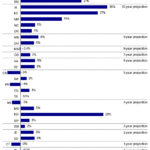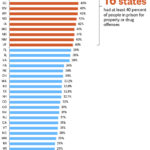Key Visualizations in This Part
For decades, state leaders have faced growing correctional populations and ballooning prison costs.
Recently, states have begun identifying and addressing the challenges within their criminal justice systems that caused these increases and reducing the size of their correctional populations while maintaining public safety.
Since 2010, more than 30 states have participated in the Justice Reinvestment Initiative (JRI) to rigorously analyze criminal justice population trends, reduce spending on ineffective public safety strategies, reinvest in what works, and document outcomes of public safety innovations.
Through JRI, states have found that
- They need to examine changes in prison and supervision populations and costs to ensure that public safety dollars are spent effectively and efficiently;
- Evidence-based administrative and legislative policy can improve public safety while averting growth or reducing prison populations;
- Averted or saved prison construction and operating costs can be calculated, and a portion may be reinvested in public safety strategies through a variety of budgetary mechanisms; and
- Impacts of policy changes and reinvestments can and should be measured and published.
State JRI efforts have had significant impacts on controlling criminal justice spending, averting growth in prison populations, and increasing public safety. Between 2010 and 2016, states implementing a Justice Reinvestment approach reported initial collective savings or averted costs exceeding $1.1 billion.[1] Additionally, states reported collective reinvestments of $551 million between 2010 and 2017 in strategies to improve public safety, with nearly 1 of every 4 dollars going to community-based treatment and services.[2] Most of these states saw a drop in crime rates during the period of cost reductions and reinvestment.[3]
Key Strategies For Success
While every state must develop its own specific approach to generating savings and reinvesting in public safety, these four strategies can help states identify and implement a plan to achieve results:
- Strategy 1: Examine drivers of corrections costs.
- Strategy 2: Develop data-driven policy options to improve public safety.
- Strategy 3: Reinvest in strategies that improve public safety.
- Strategy 4: Track results.
Additional Resources
Justice Reinvestment Initiative
The U.S. Department of Justice’s Bureau of Justice Assistance (BJA), in partnership with The Pew Charitable Trusts, launched the Justice Reinvestment Initiative (JRI) in 2010 to support states in using their criminal justice data to design and implement innovative, data-driven, and comprehensive approaches to shift resources toward more cost-effective public safety strategies. Since 2010, more than 30 states have used a Justice Reinvestment approach. To learn more, see Justice Reinvestment.
Samantha Harvell et al, “Reforming Sentencing and Corrections Policy: The Experience of Justice Reinvestment Initiative States,” (Washington, DC: The Urban Institute, 2016).
Jeremy Welsh-Loveman and Samantha Harvell, “Justice Reinvestment Initiative Data Snapshot,” (Washington, DC: The Urban Institute, 2018).
Adam Gelb and Jacob Denney, “National Prison Rate Continues to Decline Amid Sentencing, Reentry Reforms,” (Washington, DC: The Pew Charitable Trusts, 2018).




